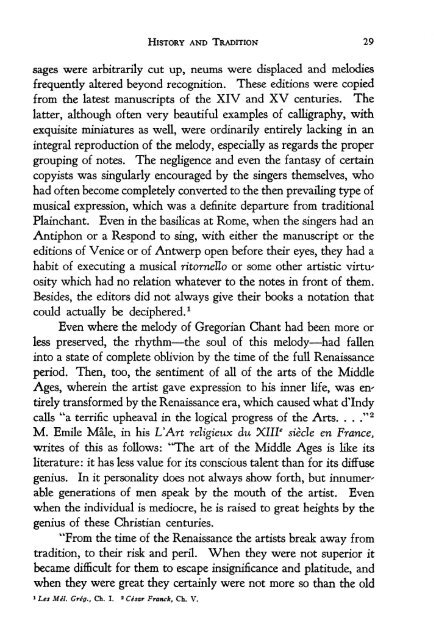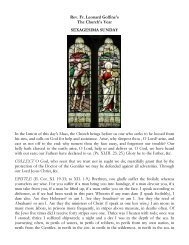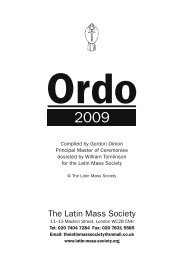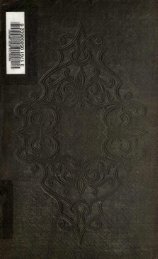The Spirit of Gregorian Chant - Church Music Association of America
The Spirit of Gregorian Chant - Church Music Association of America
The Spirit of Gregorian Chant - Church Music Association of America
You also want an ePaper? Increase the reach of your titles
YUMPU automatically turns print PDFs into web optimized ePapers that Google loves.
HISTORY AND TRADITION 29<br />
sages were arbitrarily cut up, neums were displaced and melodies<br />
frequently altered beyond recognition. <strong>The</strong>se editions were copied<br />
from the latest manuscripts <strong>of</strong> the XIV and XV centuries. <strong>The</strong><br />
latter, although <strong>of</strong>ten very beautiful examples <strong>of</strong> calligraphy, with<br />
exquisite miniatures as well, were ordinarily entirely lacking in an<br />
integral reproduction <strong>of</strong> the melody, especially as regards the proper<br />
grouping <strong>of</strong> notes. <strong>The</strong> negligence and even the fantasy <strong>of</strong> certain<br />
copyists was singularly encouraged by the singers themselves, who<br />
had <strong>of</strong>ten become completely converted to the then prevailing type <strong>of</strong><br />
musical expression, which was a definite departure from traditional<br />
Plainchant. Even in the basilicas at Rome, when the singers had an<br />
Antiphon or a Respond to sing, with either the manuscript or the<br />
editions <strong>of</strong> Venice or <strong>of</strong> Antwerp open before their eyes, they had a<br />
habit <strong>of</strong> executing a musical ritornello or some other artistic virtu'<br />
osity which had no relation whatever to the notes in front <strong>of</strong> them.<br />
Besides, the editors did not always give their books a notation that<br />
could actually be deciphered. 1<br />
Even where the melody <strong>of</strong> <strong>Gregorian</strong> <strong>Chant</strong> had been more or<br />
less preserved, the rhythm—the soul <strong>of</strong> this melody—had fallen<br />
into a state <strong>of</strong> complete oblivion by the time <strong>of</strong> the full Renaissance<br />
period. <strong>The</strong>n, too, the sentiment <strong>of</strong> all <strong>of</strong> the arts <strong>of</strong> the Middle<br />
Ages, wherein the artist gave expression to his inner life, was entirely<br />
transformed by the Renaissance era, which caused what dlndy<br />
calls "a terrific upheaval in the logical progress <strong>of</strong> the Arts. . . ." 2<br />
M. Emile Male, in his L'Art religieux du XLII e siecle en France,<br />
writes <strong>of</strong> this as follows: "<strong>The</strong> art <strong>of</strong> the Middle Ages is like its<br />
literature: it has less value for its conscious talent than for its diffuse<br />
genius. In it personality does not always show forth, but innumerable<br />
generations <strong>of</strong> men speak by the mouth <strong>of</strong> the artist. Even<br />
when the individual is mediocre, he is raised to great heights by the<br />
genius <strong>of</strong> these Christian centuries.<br />
"From the time <strong>of</strong> the Renaissance the artists break away from<br />
tradition, to their risk and peril. When they were not superior it<br />
became difficult for them to escape insignificance and platitude, and<br />
when they were great they certainly were not more so than the old<br />
i Les Mel. Grig., Ch. I. » Cesar Franck, Ch. V.
















